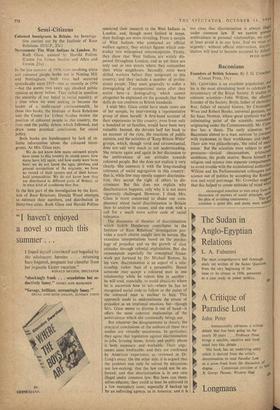Semi -Citizens
Coloured Immigrants in Britain. An Investiga- tion carried out by the Institute of Race Relations. (O.U.P., 25s.) Newcomers: The West Indians in London. By Ruth Glass, assisted by Harold Pollins. (Centre for Urban Studies and Allen and Un win, 21s,) IN the late summer of 1958, riots involving white and coloured people broke out in Notting Hill and Nottingham. Such riots had occurred spdradically since 1919—one as recently as 1954 —but the events two years ago shocked public opinion as never before. They called in question the sincerity of our belief in racial, equality, at a time when we were seeking to become the leader of a multi-racial commonwealth. In these two books, the Institute of RaCe Relations and the Centre for Urban Studies review the position of coloured people in this country, the riots and the public debate which followed, and draw some practical conclusions for social policy.
Both books are handicapped by lack of re- liable information about the coloured immi- grants. As Mrs. Glass says, We do not know bow many coloured people have come to this country in recent years; how many have left again; and how many were born here; we do not know the ages, previous and present occupations of the migrants; we have no record of their careers and of their house- hold composition. We do not know how they are distributed in different parts of Britain, or in what kind of conditions they live.
In the first part of the investigation by the Insti- tute of Race Relations, Donald Wood attempts, to estimate their numbers, and distribution in thirty-two cities. Ruth Glass and Harold Pollins
restricted their research to the West Indians in London, and, though more limited in scope, their findings are more revealing. From a sample of West Indians who contacted an official welfare agency, they extract figures which con- tradict two widespread misconceptions. Firstly, they show that West Indians are widely dis- persed throughout London, and as yet there are only one or two streets where they outnumber their white neighbours. Secondly, most were skilled workers before they emigrated to this country, and they include a number of profes- sional people. They seem generally to suffer a downgrading of occupational status after they arrive here—a downgrading which cannot altogether be explained on the grounds that their skills do not conform to British standards.
I wish Mrs. Glass could have made more use of her sample, by interviewing a representative group of them herself. A first-hand account of their experiences in this country, even from only a hundred or so families, would have been very valuable. Instead, she devotes half her book to an account of the riots, the reactions of public opinion, and the activities of 'Keep Britain White' groups, which, though vivid and circumstantial, does not 'add very much to our understanding. She returns again and again in her discussion to the ambivalence of our attitudes towards coloured people. But she does not explain it very clearly. She connects it with the long-standing tolerance of social segregation in this country: that is, while few may openly support discrimina- tion, they accept the right of others to dis- criminate. But this does not explain why discrimination happens, only why it is not more vigorously challenged. However, I think Mrs. Glass is more concerned to shake our com- placency about racial discrimination in Britain than to analyse its causes, and she ends with a call for a much more active code of racial tolerance.
The discussion of theories of discrimination which • Judith Henderson contributes to the Institute of Race Relations' investigation pro- vides a much clearer insight into its nature. She examines interpretations based on the psycho- logy of prejudice and on the growth of class attitudes through colonial exploitation. But she recommends especially the conceptual frame- work put forward by Dr. Michael Banton. In his view, discrimination is an aspect of a rela- tionship, rather than of a personality. Hence someone may accept a coloured man in one relationship while he rejects him in another : he will tend, especially, to avoid situations where he is uncertain how to act—where he has no recognised social code to follow or the status of the coloured man is unclear to hini. This approach tends to underestimate the extent of prejudice as an irrational emotion, but—though Mrs. Glass seems to dismiss it out of hand—it offers the most coherent explanation of the ambivalence which she continually brings out.
But whatever the disagreements in theory, the practical conclusions of the authors of these two studies are virtually unanimous. In particular, they agree that legislation against discrimination in jobs, housing leases, hotels and public places is both necessary and workable. Their argu- ments seem irrefutable, and they are confirmed by American experience, as reviewed in Dr.
Long's essay. On the other side, it is argued that the problem can only be solved by education, not law-making; that the law could not be en- forced; and that discrimination is in any case illegal under common law. But laws can them- selves educate; they could at least be enforced in
a few exemplary cases, especially if backed up by an enforcing agency, as in America; and it is not clear that discrimination is always illegal under common law. If we cannot prevent ambivalence in personal relationships, we could at least avoid it in our laws. And we must act urgently: without official intervention, discron' =bon will tend to become accepted by default' PETER MkRRI5






































 Previous page
Previous page